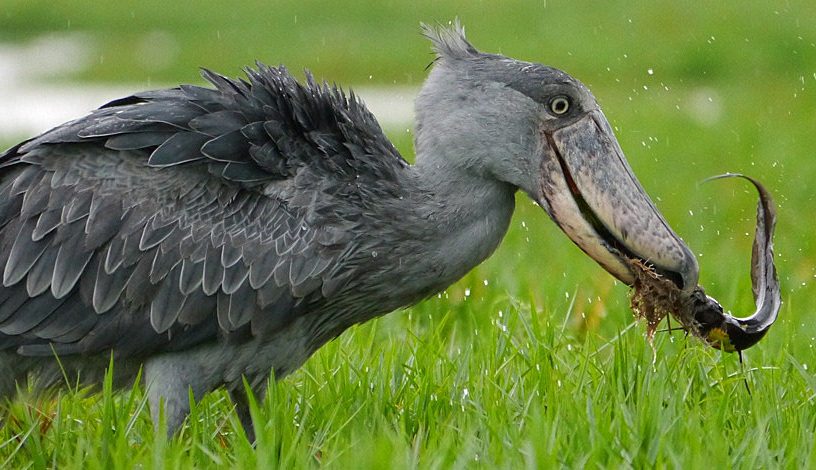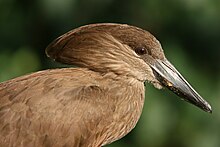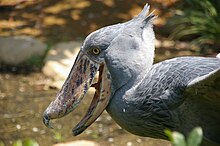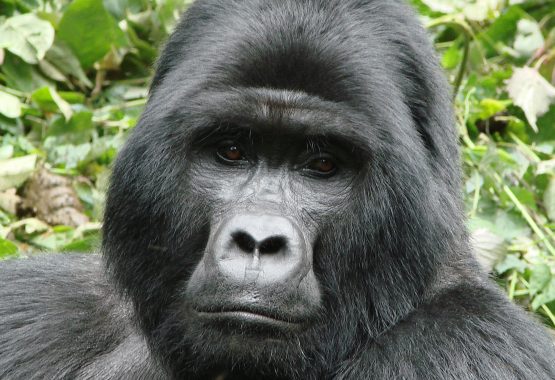The shoebill (Balaeniceps rex) also known as whalehead, whale-headed stork, or shoe-billed stork, is a very large stork-like bird. It derives its name from its enormous shoe-shaped bill. It has a somewhat stork-like overall form and has previously been classified with the storks in the order Ciconiiformes based on this morphology. However, genetic evidence places it with the Pelecaniformes. The adult is mainly grey while the juveniles are browner. It lives in tropical east Africa in large swamps from Sudan to Zambia.
Taxonomy and systematics
The shoebill was known to both ancient Egyptians and Arabs, but was not classified until the 19th century, after skins and eventually live specimens were brought to Europe. John Goulddescribed it in 1850, giving it the name Balaeniceps rex. The genus name comes from the Latinwords balaena “whale”,and caput “head”, abbreviated to -ceps in compound words.
Traditionally allied with the storks (Ciconiiformes), it was retained there in the Sibley-Ahlquist taxonomy which lumped a massive number of unrelated taxa into their “Ciconiiformes”. More recently, the shoebill has been considered to be closer to the pelicans (based on anatomical comparisons) or the herons (based on biochemical evidence; Hagey et al., 2002). Microscopic analysis of eggshell structure by Konstantin Mikhailov in 1995 found that the eggshells of shoebills closely resembled those of other Pelecaniformes in having a covering of thick microglobular material over the crystalline shells. A recent DNA study reinforces their membership of the Pelecaniformes.
So far, two fossil relatives of the shoebill have been described: Goliathia from the early Oligocene of Egypt and Paludavis from the Early Miocene of the same country. It has been suggested that the enigmatic African fossil bird Eremopezus was a relative too, but the evidence for that is unconfirmed. All that is known of Eremopezus is that it was a very large, probably flightless bird with a flexible foot, allowing it to handle either vegetation or prey.
The shoebill is a tall bird, with a typical height range of 110 to 140 cm (43 to 55 in) and some specimens reaching as much as 152 cm (60 in). Length from tail to beak can range from 100 to 140 cm (39 to 55 in) and wingspan is 230 to 260 cm (7 ft 7 in to 8 ft 6 in). Weight has reportedly ranged from 4 to 7 kg (8.8 to 15.4 lb). A male will weigh on average around 5.6 kg (12 lb) and is larger than a typical female of 4.9 kg (11 lb). The signature feature of the species is its huge, bulbous bill, which is straw-coloured with erratic greyish markings. The exposed culmen (or the measurement along the top of the upper mandible) is 18.8 to 24 cm (7.4 to 9.4 in), the third longest bill among extant birds after pelicans and large storks, and can outrival the pelicans in bill circumference, especially if the bill is considered as the hard, bony keratin portion. The sharp edges in the mandibles help the shoebill to decapitate their prey and also to discard any vegetation after prey has been caught. As in the pelicans, the upper mandible is strongly keeled, ending in a sharp nail. The dark coloured legs are fairly long, with a tarsus length of 21.7 to 25.5 cm (8.5 to 10.0 in). The shoebill’s feet are exceptionally large, with the middle toe reaching 16.8 to 18.5 cm (6.6 to 7.3 in) in length, likely assisting the species in its ability to stand on aquatic vegetation while hunting. The neck is relatively shorter and thicker than other long-legged wading birds such as herons and cranes. The wings are broad, with a wing chord length of 58.8 to 78 cm (23.1 to 30.7 in), and well-adapted to soaring.
The plumage of adult birds is blue-grey with darker slaty-grey flight feathers. The breast presents some elongated feathers, which have dark shafts. The juvenile has a similar plumage colour, but is a darker grey with a brown tinge. When they are first born, shoebills have a more modestly-sized bill, which is initially silvery-grey. The bill becomes more noticeably large when the chicks are 23 days old and becomes well developed by 43 days.








